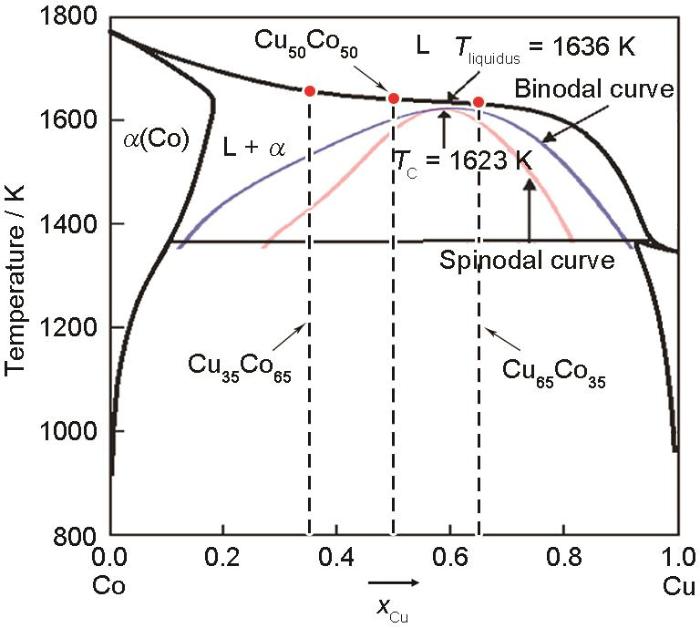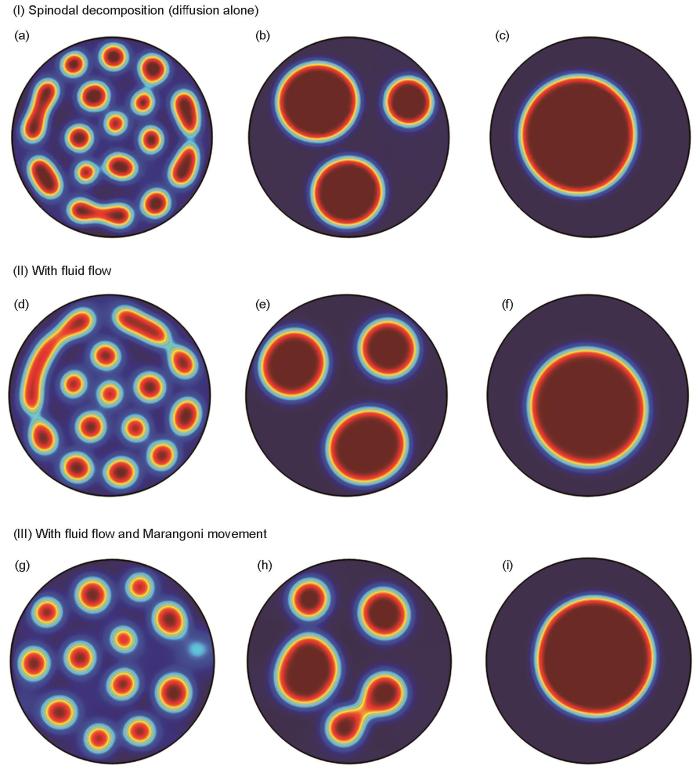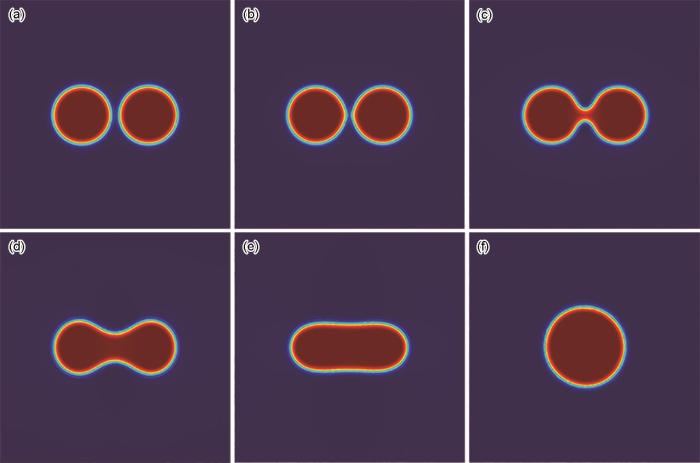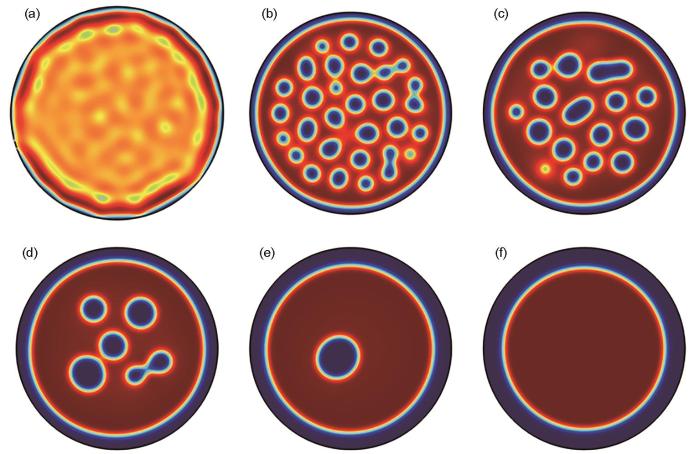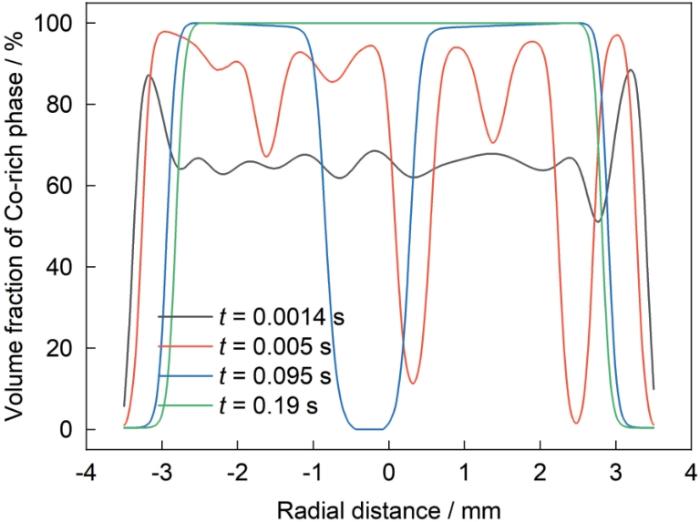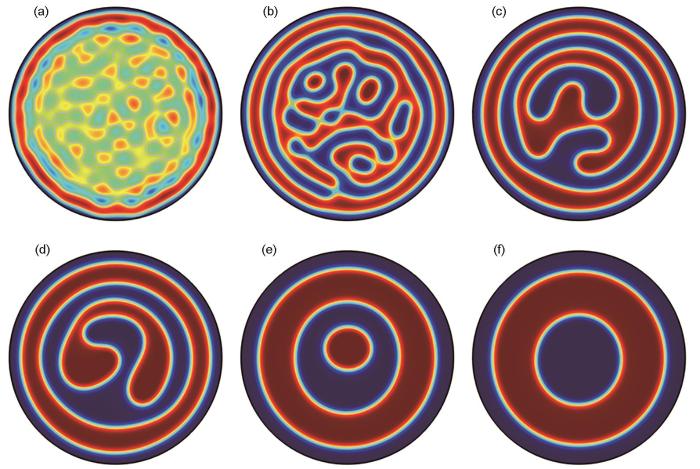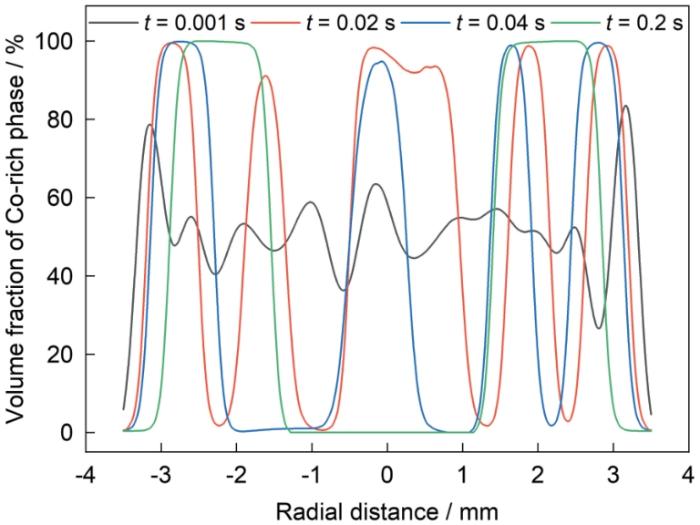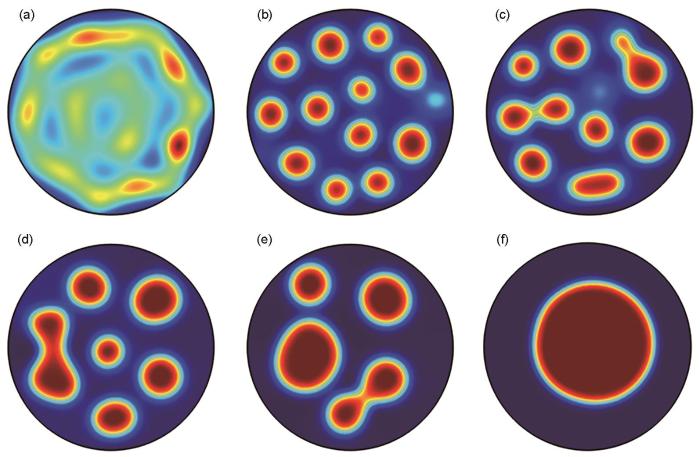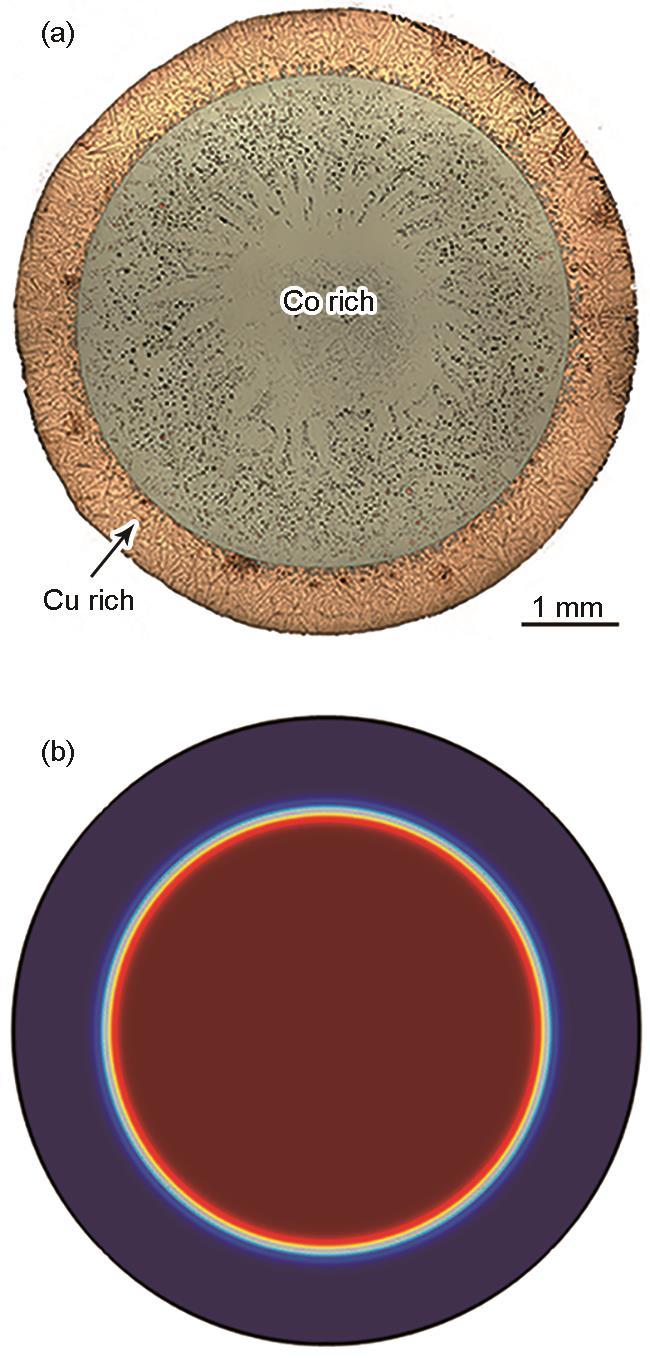然而,Cu-Co合金发生液态相分离的尺度无论在时间还是空间上都非常小,加之其实验研究是在高温环境中进行,故对其凝固过程进行原位观测具有很高的难度。难混溶合金的液相分离问题涉及相变过程中的扩散、对流、Ostwald熟化、Stokes运动以及Marangoni运动等综合作用。因此,仅依靠实验研究对合金凝固的动力学特征和组织形成的微观机制进行系统分析是难以进行的。
近年来,由于材料理论基础和计算能力的不断提高,利用数值模拟方法对合金的微观相变过程进行研究成为一种趋势[11~17]。相比于实验,计算机仿真能够将材料在人为选取的空间和时间上的组织、成分等变化情况较好地反映出来,使研究者能够清晰地观察到通过实验方法不能观测的现象。同时,模拟可以在较短的时间内,对各种系统和环境下的实验结果进行验证及预测,为新材料的研制提供依据。Qin等[18]采用数值模拟方法研究了Cu-Fe合金在空间环境下形成的核壳组织的演化过程,发现由于表面偏析的作用,经液相分离形成的富Cu相始终构成核壳结构的外壳层。Shi等[19]通过计算机模拟研究了气体雾化法制备的Cu-Fe合金核壳组织的演化过程,发现了调幅分解和相分离引发的流体流动、第二相液滴之间的碰撞凝并等机制在液相分离不同阶段发挥的作用,并表明它们之间的相互作用与系统尺度息息相关。此外,Wang等[20]利用相场模拟研究了落管法制备的Fe-Sn合金的液相分离凝固组织,发现液相分离过程中第二相经历了成核、聚集凝并和Ostwald熟化3个阶段。
可见,数值模拟方法是研究难混溶合金组织演变过程的一种有效手段。然而目前对该类问题的模拟研究相对实验研究而言要少得多,尤其对于尺度较大(介观尺度(10-6~10-4 m)以上)的体系。本工作旨在通过数值模拟方法研究难混溶Cu-Co系合金在熔融玻璃净化结合循环过热条件下的液相分离机制和第二相的生长动力学。
根据Cu-Co合金二元相图,在难混溶间隙的不同位置选择了3种成分的合金(Cu35Co65、Cu50Co50和Cu65Co35,摩尔分数,%),如图1所示,采用相场耦合流体流动和Marangoni运动的模型进行模拟,并将模拟结果与实验结果对比验证。
图1
图1
3种合金在Cu-Co系二元相图中的位置
Fig.1
Positions of three alloys selected from Cu-Co binary system (xCu—molar fraction of Cu, Tliquidus—liquidus temperature of the alloy, TC—critical temperature of spinodal decomposition)
1 数学模型与数值方法
式中,
参数
参数
质量和动量传递由Navier-Stokes方程表示:
式中,
表面张力定义为:
式中,
在液滴状熔体中,Reynolds数小于
式中,
在边界处施加以下边界条件:
式中,
计算区域内的流体传热考虑了对流和传导2种形式,方程如下:
式中,
在计算区域边界处,使用对流热通量边界条件,由边界与环境之间的温差驱动:
式中,
合金的初始浓度的随机波动幅度为0.05。局部初始速率为0。模拟中参数
上述方程在二维Cartesian坐标下采用有限元法求解。模拟在半径
2 结果与讨论
2.1 流体流动和Marangoni运动在液相分离过程中的作用
为了探索液相分离和随后的粗化过程中微观组织演化的具体情况,以及流体流动和Marangoni运动在核壳微观结构形成中的作用,进行了3个并行条件的模拟,即分别考虑了(Ⅰ) 仅扩散、(Ⅱ) 扩散和流体流动以及(Ⅲ) 同时考虑扩散、流体流动和Marangoni运动,在上述3种条件下,对R = 3.5 mm的Cu65Co35初始熔体进行模拟,结果如图2所示。需要指出的是,本模拟基于相场法,模拟结果以相场值(相场值范围为0~1,由蓝到红的渐变颜色表示)代指各相的体积分数。当相场值趋近于0时,结果更接近蓝色,代指富Cu相;当相场值趋近于1时,结果更接近红色,代指富Co相,两相间存在具有一定厚度的过渡区。
图2
图2
模拟的Cu65Co35合金液相分离形成的核壳微观结构
Fig.2
Simulated core-shell microstructure formed by liquid phase separation of Cu65Co35 alloy (Different colors represent different phase field values. It indicates Cu-rich phase when the colors approach blue and Co-rich phase when the colors approach red. The same in Figures below. t—time)
(a) t = 0.007 s (d) t = 0.005 s (g) t = 0.007 s
(b) t = 0.25 s (e) t = 0.1 s (h) t = 0.024 s
(c) t = 1.4 s (f) t = 0.825 s (i) t = 0.22 s
| (a) t = 0.007 s | (b) t = 0.25 s | (c) t = 1.4 s |
| (d) t = 0.005 s | (e) t = 0.1 s | (f) t = 0.825 s |
| (g) t = 0.007 s | (h) t = 0.024 s | (i) t = 0.22 s |
通过以上模拟,流体流动和Marangoni运动在合金液相分离形成核壳结构过程中的作用可以总结为:① 液相分离产生的流体流动通过促使第二相液滴之间的凝聚,从而加快了第二相的粗化过程;② 液滴的Marangoni运动使第二相液滴向中心(高温区)移动,进一步加速了第二相液滴之间的凝聚,并使得最终的富Co核心相位于富Cu基质相的中心。
2.2 Ostwald熟化与凝并过程
为了更直观地探究第二相的生长动力学机制,对Ostwald熟化与第二相间的凝并过程进行了单独模拟。
2.2.1 Ostwald熟化模拟
为了模拟Ostwald熟化现象,在8 mm × 8 mm正方形区域(富Cu基体)中心的水平位置上设置了2个半径不相等的第二相富Co液滴,模拟过程中系统温度恒定,初速度为0,不施加额外体积力,模拟结果如图3所示。结果表明,2个第二相液滴不直接接触,大液滴随时间增长而逐渐长大,而小液滴则逐渐消失。根据非对称液滴的Gibbs-Thomson效应,大液滴会消耗周围小液滴的溶质,以保持自身的生长。在热力学角度,单位体积的小液滴比大液滴具有更高的Gibbs自由能,导致小液滴在两相平衡时其附近母相的组元浓度偏高,这可以由公切线法则得出。母相组元浓度的差异使大小液滴附近的母相之间存在浓度梯度,溶质原子会自发地由高浓度区向低浓度区扩散,使得大液滴持续处于过饱和溶液中,并不断从中吸取溶质而长大,则小液滴会不断变小直至消失,其溶质被转移到了大液滴中。需要指出的是,小液滴并非直接被大液滴吸收凝并,其驱动力是由第二相液滴半径不同导致的自由能差。
图3
图3
Ostwald熟化过程——显示了不同时刻第二相液滴的演化过程
Fig.3
Ostwald ripening process showing the evolution of the second phase droplets at different time
(a) t = 0.001 s (b) t = 0.13 s (c) t = 0.25 s (d) t = 0.35 s (e) t = 0.45 s (f) t = 0.5 s
如图3所示,随着时间的推移,较小的液滴不断衰减,最终消失。在熟化阶段的初期,液滴的衰减速率较慢,之后,随液滴尺寸越来越小,其衰减速率逐渐加快。这是由于初期阶段小液滴与大液滴之间尺寸相差较小,所产生的驱动力较小,因而小液滴初期的衰减速率较慢;随时间推移,小液滴的尺寸不断变小,同时大液滴的尺寸不断增大,两液滴的尺寸差异更大,使得驱动力变大,从而导致小液滴的减小速率变大。相比之下,大液滴的增长速率在各阶段都相对稳定,这是由于大液滴的尺寸较大,其尺寸增大单位长度所需溶质的量要比小液滴尺寸减小单位长度所消耗的溶质的量多得多,因此大液滴的增长速率相对平稳且缓慢。
2.2.2 第二相凝并过程模拟
图4
图4
第二相的凝并过程——显示了凝并过程中不同时刻下液桥的形成与演化
Fig.4
Condensation process of the second phase showing the formation and evolution of the liquid bridge at different time during the condensation process
(a) t = 0.002 s (b) t = 0.015 s (c) t = 0.02 s (d) t = 0.035 s (e) t = 0.1 s (f) t = 0.56 s
从热力学角度出发,液滴在凝并过程中体系自由能是降低的,故2个互相接近液滴的凝并现象是自发进行的。假定存在于某一温度体系中的2个液滴,其半径分别为
由
则有:
由于凝并前后两液滴的体积并没有发生变化,因此可以不计体积自由能的改变,仅考虑表面能的改变,故凝并过程的自由能变化
式中,
根据上述推导可以得出,在恒温条件下,体系自由能会随液滴的凝并而降低,即液滴的凝并现象是自发的,模拟得出的结果与推导分析的结论是一致的。
2.3 体积分数的影响
2.3.1 Cu35Co65合金的液相分离
图5为模拟得到的Cu35Co65合金在不同时刻的微观组织。模拟结果表明,在早期阶段(t = 0.0014 s),由于表面偏析作用,合金的液相分离在表面先于内部发生,在表面形成一个富Cu层(蓝色)和富Co层(红色)。在熔体中,由于表面张力作用,富Cu相作为第二相,以球体的形式生成(t = 0.005s)。根据图5b和c可知,初期阶段生成了大量的第二相液滴,它们之间的间距较小,并且生成的第二相液滴会扰动熔体导致流体流动,促使第二相之间的碰撞凝聚。当第二相液滴碰撞接触时,为减小表面能,它们将凝并为一个更大的液滴。需要指出,由于第二相液滴之间始终存在半径差异,根据前文所述,Ostwald熟化的驱动力始终存在,因此第二相在初期阶段的长大方式为碰撞凝并与Ostwald熟化并存,但以碰撞凝并机制为主。由图5d可以看出,随第二相的长大,其数量不断减少,它们之间的间距也会增大,导致液滴碰撞的概率减小。此时,第二相液滴的生长机制主要为Ostwald熟化,并且Marangoni运动使富Cu球体向中心(高温区)移动。同时,由于富Cu相与富Co相之间的界面是连续的,故可将熔体最外层的富Cu层与富Co相之间的界面视为一个大液滴的外径,其与熔体内部的各富Cu相之间存在较大的半径差,因此,内部富Cu相的溶质向边界迁移,使外层的富Cu边界层增厚,最终单一富Co相位于中心,形成核壳结构(t = 0.19 s)。
图5
图5
Cu35Co65合金液相分离演变过程的微观组织
Fig.5
Simulated microstructures of Cu35Co65 alloy during liquid phase separation
(a) t = 0.0014 s (b) t = 0.005 s (c) t = 0.01 s (d) t = 0.0375 s (e) t = 0.095 s (f) t = 0.19 s
为了探究表面偏析和Marangoni运动对液相分离过程中浓度场的影响,计算了不同时刻Co在径向上的浓度分布,如图6所示,横坐标表示径向距离,纵坐标表示富Co相的体积分数。在早期阶段(t = 0.0014 s),由于Cu在表面的富集,浓度分布在表面处形成了一个波峰和一个波谷,波峰表示富Co相,波谷表示富Cu相。随着相分离的进行,在内部也出现富Cu相,并在Marangoni运动的驱动下向中心聚集,同时更多的Cu通过Ostwald熟化机制由内向外扩散(t = 0.095 s)。因此,表面的富Cu层厚度逐渐增加,中心则成为单一的富Co相(t = 0.19 s)。
图6
图6
Cu35Co65合金液相分离过程中不同时刻Co浓度与径向距离的关系
Fig.6
Co concentration vs radial distance during liquid phase separation for Cu35Co65 alloy at different time
2.3.2 Cu50Co50合金的液相分离
Cu50Co50合金的液相分离组织演变过程如图7所示,相应的Co浓度分布如图8所示。在该成分下,表面偏析过程类似于Cu35Co65合金,在表面形成一个富Cu层和一个富Co层(t = 0.001 s)。在熔体内部,由于2种组分的量相同,基体分离为双连续相而不是球体。由图7b和c可以看出,在初期阶段,液相分离引起的流体流动促进第二相之间的碰撞接触,为减小系统的表面能,分散的第二相不断聚结。此时,第二相的长大机制方式主要为碰撞凝并机制。随时间推移,在表面张力和Marangoni力的综合作用下,第二相逐渐长大并向中心聚拢,微观组织由双连续相演变为4层核壳结构,如图7e所示。此时与前文所述同理,由于Ostwald熟化的驱动力始终存在,中心富Co相和富Cu相的溶质分别向外层的富Co层和富Cu层扩散,之后演变为3层核壳结构,如图7f所示。此时,3层核壳中心的富Cu核在Ostwald熟化驱动力下会继续向外层的富Cu层扩散,若有足够的时间,最终将形成以单一富Co核为核心的双层核壳结构,结果将在下一节给出。
图7
图7
Cu50Co50合金液相分离演变过程的模拟微观组织
Fig.7
Simulated microstructures of Cu50Co50 alloy during liquid phase separation
(a) t = 0.001 s (b) t = 0.004 s (c) t = 0.02 s (d) t = 0.04 s (e) t = 0.14 s (f) t = 0.2 s
图8
图8
Cu50Co50合金液相分离过程中不同时刻Co浓度与径向距离的关系
Fig.8
Co concentration vs radial distance during liquid phase separation for Cu50Co50 alloy at different time
2.3.3 Cu65Co35合金的液相分离
图9
图9
Cu65Co35合金液相分离演变过程的模拟微观组织
Fig.9
Simulated microstructures of Cu65Co35 alloy during liquid phase separation
(a) t = 0.0035 s (b) t = 0.007 s (c) t = 0.01 s (d) t = 0.015 s (e) t = 0.024 s (f) t = 0.22 s
图10
图10
Cu65Co35合金液相分离过程中不同时刻Co浓度与径向距离的关系
Fig.10
Co concentration vs radial distance during liquid phase separation for Cu65Co35 alloy at different time
3种不同成分Cu-Co合金的模拟结果表明,在核壳结构形成过程中,无论构成核、壳相的体积分数多少,较高熔点的富Co相始终处于核心位置。
2.4 模拟与实验结果的对比
图11
3 结论
(1) 对Cu65Co35合金进行了3个并行条件的模拟,结果表明:流体流动可以促进第二相液滴之间的凝聚,加快第二相的粗化过程;Marangoni运动使第二相液滴向中心(高温区)迁移,进一步加速第二相的凝聚,并导致富Co相位于核壳结构的中心。
(2) 根据对Cu-Co系合金演化过程的模拟,Cu35Co65合金的液相分离经历了从弥散结构到3层核壳再到双层核壳结构的转变;Cu50Co50合金的液相分离组织遵循“双连续相→4层核壳→3层核壳→双层核壳”的演变路线;Cu65Co35合金液相分离形成的双层核壳结构则是由初始的弥散形态演化而来的。在形成核壳结构的过程中,无论各组分的体积分数多少,熔点较高的富Co相最终都处于核心位置上。
(3) 将模拟组织与实验结果进行对比,结果表明2者在组织形貌上具有很高的相似度,验证了模拟的正确性和可靠性。
参考文献
Liquid-liquid phase separation in immiscible Cu-Co alloy
[J].
Liquid separating behavior of Cu-Co alloys under deep supercooling
[J].
深过冷条件下Cu-Co合金的液相分解
[J].
Study of giant magnetoresistence of Co/Cu multilayers prepared by electrochemical deposition
[J].
Co/Cu纳米多层膜的制备及巨磁阻性能的研究
[J].
Effect of high magnetic field on solidification microstructure evolution of a Cu-Fe immiscible alloy
[J].
Effect of high magnetic field on the microstructure evolution behavior of undercooled Cu-Co alloy
[J].
强磁场对过冷Cu-Co合金组织演化行为的影响
[J].
Continuous solidification of Al-Bi immiscible alloys under the direct current
[J].
直流电流作用下Al-Bi偏晶合金连续凝固研究
[J].开展了直流电流作用下Al-Bi偏晶合金的连续凝固试验,研究了直流电流密度、合金成分、凝固速度以及基体熔体与弥散相液滴电导率等因素对偏晶合金凝固组织形成的影响。结果表明,直流电流能够促使偏晶合金液-液相变过程中弥散相液滴发生径向迁移。当弥散相液滴的电导率小于基体熔体的电导率时,弥散相液滴在直流电流作用下由试样中心向试样表面迁移;当弥散相液滴的电导率大于基体熔体的电导率时,弥散相液滴在电流作用下由试样表面向试样中心迁移。
Solidification behaviour of undercooled Co-Cu alloys showing a metastable miscibility gap
[J].
Dynamics of core-shell particle formation in drop-tube processed metastable monotectic alloys
[J].
Solidification microstructure evolution and its corresponding mechanism of metastable immiscible Cu80Fe20 alloy with different cooling conditions
[J].
Neutron computed tomography of phase separation structures in solidified Cu-Co alloys and investigation of relationship between the structures and melt convection during solidification
[J].
Numerical simulation of diffusion induced phase separation and coarsening in binary alloys
[J].
A study of phase separation in ternary alloys
[J].
Phase field simulations in miscibility gaps
[J].
A phase-field and electron microscopy study of phase separation in Fe-Cr alloys
[J].
Kinetics of phase separation in iron-based ternary alloys. II. Numerical simulation of phase separation in Fe-Cr-X (X = Mo, Cu) ternary alloys
[J].
A phase-field study on interaction process of moving grain boundary and spinodal decomposition
[J].
运动晶界与调幅分解相互作用过程的相场法研究
[J].
Atomic scale investigation of nucleation process by the phase field crystal model
[J].
原子尺度形核过程的晶体相场法研究
[J].
Simulated evolution process of core-shell microstructures
[J].
Self-organization of core-shell and core-shell-corona structures in small liquid droplets
[J].
Homogeneous granular microstructures developed by phase separation and rapid solidification of liquid Fe-Sn immiscible alloy
[J].
Reconfigurable magnetic slime robot: Deformation, adaptability, and multifunction
[J].
A second-order convex splitting scheme for a Cahn-Hilliard equation with variable interfacial parameters
[J].In this paper, the MMC-TDGL equation, a stochastic Cahn-Hilliard equation with a variable interfacial parameter, is solved numerically by using a convex splitting scheme which is second-order in time for the non-stochastic part in combination with the CrankNicolson and the Adams-Bashforth methods. For the non-stochastic case, the unconditional energy stability is obtained in the sense that a modified energy is non-increasing. The scheme in the stochastic version is then obtained by adding the discretized stochastic term. Numerical experiments are carried out to verify the second-order convergence rate for the non-stochastic case, and to show the long-time stochastic evolutions using larger time steps.
Hydrodynamic effects in three-dimensional microphase separation of block copolymers: Dynamic mean-field density functional approach
[J].
Spinodal decomposition in binary mixtures
[J].




